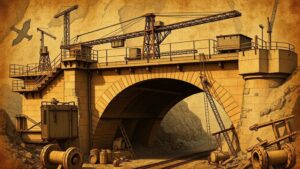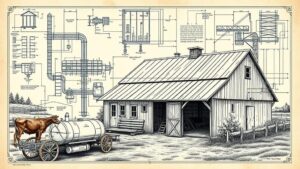Exploring Abandoned Gold Refinery Foundations for Hidden Mining Tools
Exploring Abandoned Gold Refinery Foundations for Hidden Mining Tools
The legacy of gold mining in various regions around the world is poised to be an important subject of study, particularly in understanding the material culture left by past mining operations. Abandoned gold refineries serve as fascinating locations for archaeologists and historians alike, as they not only reveal the technology and methods employed in extraction but also may house hidden tools and equipment that were once pivotal to the mining industry. This paper explores the significance of conducting research on these abandoned sites, the methods used for investigation, and the implications of findings related to historical mining practices.
Historical Context of Gold Mining
Gold mining has been a crucial economic activity since ancient times. California Gold Rush (1848-1855), the Klondike Gold Rush (1896-1899), and the Witwatersrand Gold Rush in South Africa (1886) are just a few examples of significant events that have shaped global economies and migration patterns. According to the United States Geological Survey (USGS), the peak of gold production in the U.S. occurred in 1900, producing over 3 million ounces that year alone.
Abandoned Refinery Foundations: What Lies Beneath
Abandoned gold refineries, such as the ones found in Northern California and Colorado, provide rich sources of historical artifacts. e sites often contain remnants of machinery, chemicals, and, notably, mining tools that were discarded or lost throughout operations. A systematic study of these foundations allows researchers to uncover:
- Vintage mining equipment such as picks, shovels, and sluice boxes.
- Refining tools used in the gold extraction process, including retorts and amalgamation tables.
- Cultural artifacts reflecting the social life of miners, such as personal belongings.
A noteworthy example is the Reed Gold Mine in North Carolina, where numerous mining tools have been excavated since the site was established in 1799. Collecting these tools offers critical insights into the mining technologies that were prevalent during the respective periods.
Methodologies for Exploration
Research methodologies in exploring these foundations incorporate both fieldwork and technological applications. Techniques typically employed include:
- Ground Penetrating Radar (GPR): This non-invasive method helps to identify subsurface features without excavation, revealing potential tool locations.
- Magnetometry: This method detects anomalies in magnetic fields, useful for locating ferrous materials, including mining tools.
- Site Surveys: Detailed documentation and mapping of existing structures to assess the site’s historical import.
For example, a study conducted at the Eureka Mine in Idaho utilized GPR, which successfully located underground tools that had been reported lost by miners during the late 19th century.
Findings and Implications
The investigation of abandoned gold refinery foundations can lead to the uncovering of significant artifacts that contribute to the understanding of mining techniques and labor practices of the past. According to a study published in the *Journal of Historical Archaeology,* findings indicate that many tools reflect technological advancements made in the late 1800s, showcasing shifts towards more efficient mining practices.
Also, examining these tools not only helps in constructing narratives around mining but can also inform current practices in historical conservation and tourism. For example, the integration of mining heritage in educational curricula and national parks promotes awareness about environmental impacts and the socio-economic transformations arising from mining activities.
Conclusion and Future Directions
Exploring abandoned gold refinery foundations holds significant value for historical and archaeological research. e sites offer not just remnants of the past but a narrative that speaks to technological evolution, social dynamics, and economic history. Scholars and practitioners are encouraged to adopt multifaceted research methodologies combining technological and traditional archaeological approaches to reveal hidden attributes of mining tools. Future research should prioritize the preservation of these artifacts, promoting their role in educational contexts and public heritage sites.
To wrap up, the continuous study and exploration of abandoned gold refinery sites may yield important insights that help us better understand the intricate legacies of mining practices across generations.



